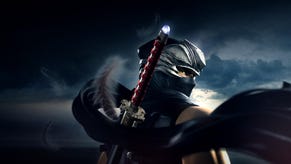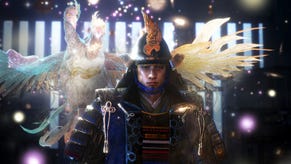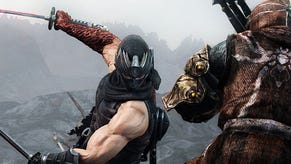Keiji Yamagishi on His Past and Future in Game Music
COVER STORY: The artist behind Ninja Gaiden's NES soundtrack opens up about returning to composing, and his future plans.
This article first appeared on USgamer, a partner publication of VG247. Some content, such as this article, has been migrated to VG247 for posterity after USgamer's closure - but it has not been edited or further vetted by the VG247 team.
Keiji Yamagishi returned from 8-bit from obscurity last year with the release of Retro-Active Pt. 1, a collection of original tunes created in the spirit of the work he did in the ’80s and ’90s as a house composer at Tecmo and Koei.
As part of USgamer's cover story profile of Brave Wave, the indie music label that's created a home for Yamagishi and a number of other talented composers of the Famicom/NES era, I met with Yamagishi while I was in Japan last September for Tokyo Game Show. We spoke about his history, his return to game music, and his upcoming projects. It's all here, including some exclusive samples of Retro-Active Pt. 2 and the chiptune arrangement of both albums — coming soon to an NES near you.
Exclusive preview: "Total Escape" from Retro-Active Pt. 2, co-composed by Ryuichi Nitta.
Keiji Yamagishi: I've been a composer since the NES era, when I was very active. I actually haven't done a lot of game music in recent years, but when I met Mohammed [Taher, Brave Wave's founder], he encouraged me to get back into it. So that's why I'm here today.
USgamer: Before you became a Famicom composer, did you study music? I was wondering if you could talk about your background.
KY: Honestly, I had no formal musical education. Before becoming a Famicom composer, I'd been in a band in college. But I had no intention of becoming a pro musician.
USG: So how did you end up becoming a composer for Tecmo?
KY: I encountered Tecmo as a candidate company — a potential company for him to join. I didn't know he was going to join Tecmo for sure, but I made it to the final interview and had an interview with the President of Tecmo. When the President of Tecmo found out that I was a musician in a band, he asked "Why don't you do music for us?" And that's how I became involved in the game industry. I actually had no intention of becoming involved in the game industry at all, no particular desire to go in. But, you know, when you're looking for work, you have to consider all your options.
USG: Had you been much of a video game fan before that?
KY: Yeah, I was playing games before then. I really liked Xevious.
USG: That game's pretty famous for its soundtrack as well. Was that an influence on you?
KY: No, video game music in general never had any particular influence or inspiration on me.
USG: What were your musical influences, then?
KY: My biggest influences were music and soundtracks from TV shows that I watched as a kid, the anime that he watched... you know, TV programs like that. I guess Western music as well — music from famous Western music artists in the '70s and '80s.
USG: How did you go about bringing those influences into the music you composed for video games?
KY: It's a bit of a challenging question, but I guess if you think about it — I try to think about what's influenced me, to reference it, and then just put it all together and dole out the music. [laughs]
USG: But it's not that simple, is it, when you're composing for Famicom, which has just three or four sound channels, and you have to work with machine code. There's no just... picking up a guitar and jamming.
KY: Yeah, making music for the NES is indeed pretty tough work. At Tecmo, it wasn't my responsibility just to make music. I also had to do the sound programming, the sound effects... making the programs that would allow the music to be output to an NES-compliant format. A lot of tasks like that that go beyond simple composing.
USG: Did you have any experience with computers or programming before that?
KY: I had absolutely no knowledge of computer programming before joining the company! I learned all that after joining Tecmo. I spent a good six months studying programming after joining the company. After that, that's when I started doing more of his actual job. Maybe six months isn't so long in the context of today, but maybe back then it might've been quite a long time.
USG: Yeah, games had shorter development cycles. What was the first game you worked on?
KY: I guess it depends on your definition of "working on." The first game that I did everything for — composition, programming, etc — would be, of course, Ninja Gaiden. If you were talking about the first game my music appeared in, though, I composed for a game called Super Ozumo, which is a sumo wrestling game. That's probably not available in America. I think someone else did the programming for that one.
USG: So, having Ninja Gaiden as your first game on your resume is really impressive. It's considered a classic, not just as a game, but also its music. To what do you attribute the fact that you created something so great right away?
Translator: I guess this is maybe my own personal note to add to this... maybe he's just being humble, but he basically attributes it to there having been only two people doing game music at the time. [laughs]
KY: One other person worked in the arcade section, so that left me with the console games. So that's why it was me who was tasked with the process of doing the music for Ninja Gaiden and Captain Tsubasa.
USG: Ninja Gaiden was so heavily influenced by manga and anime and movies, which is kind of where you were influenced in terms of music... do you think that helped?
KY: Yeah, for Ninja Gaiden and Captain Tsubasa — what was very unique about those two games is at the time, they had cutscenes in between the game sequences. Those cutscenes allowed me to very easily imagine what the music should be like. We both got inspiration from movies and whatnot, but just having those images in the game itself made it quite simple and straightforward to figure out what to compose.
USG: At the same time, the addition of cutscenes must have made the process of composing more complicated than for other games. With other games, you had stage one music, stage two music, boss music, ending music, and the game over jingle. But you had all of those things, plus you had to have different moods for when, you know, a character dies, or there's something shocking that happens, or you face off against the big boss at the end before the fight. You have to build up the tension and the mood. So it just seems like that was a lot for you to have to do as your first project.
KY: Indeed, yeah. That would have been the case. I guess volume would have been the most difficult thing when working with NES games, because the NES can't really hold that much data. Having all these cutscenes made for a laborious process. But like I mentioned earlier, actually coming up with the answer to, "What kind of music should go with this scene?" was not actually that hard.
USG: I know a lot of publishers had special Famicom chips with extra sound capabilities — Konami, Sunsoft, and Namco did. But I don't remember ever seeing anything like that for Tecmo. Did you always just work with the basic Famicom hardware capabilities?
KY: It's true, Tecmo indeed did not have any special sound chips. All I had to work with was the original sound chip set that the Famicom provided. The reason for that is because having a special chip would cost extra money, and that's not something Tecmo wanted to do.
USG: Did you ever request, "Can I have special chips so I can make better music?"
KY: Actually, I did! I asked the president of Tecmo, "Can I please use the sound chip that these other companies are using?" I was rejected, I — his request was declined because I guess Tecmo was a company that was a lot more strict with how they used their funding. They just encouraged me to make the best music that I could using the standard sound chip.
USG: Did you ever get to work on the Famicom Disk System's extra sound channel, or was that basically a dead platform by the time you started?
KY: It existed back in the day, but Tecmo didn't do anything with that system, so I had nothing to do with it as well.
USG: So did you have any special techniques as a composer and a programmer to get the most out of the basic capabilities of the Famicom?
KY: I guess in that sense, I did have a lot of techniques. But the most interesting thing I can tell you is that at Tecmo at the time, we were listening to the kind of music that people at other companies could make. One particular company that Tecmo paid a lot of attention to was Capcom, so I would listen to the soundtrack for Mega Man, and we'd would try to figure out exactly how we could reproduce... not the exact same song, but try to get the same level of fidelity and whatnot. So they spent a lot of time referencing other companies' games. Which is kind of interesting, because I ended up working with Matsumae-san from Mega Man on their own collaboration song for my album. It's kind of funny how things come full circle sometimes.
USG: What was it like working with someone whose music you had dissected and studied in the past?
KY: Actually, our connection goes back even further. I worked with Matsumae-san's husband on a separate project in the past. So it's kind of like a strange connection, but our collaboration wasn't the first time they were connected. In that sense, it is quite interesting.










